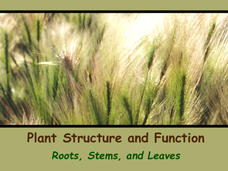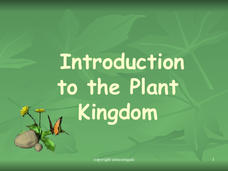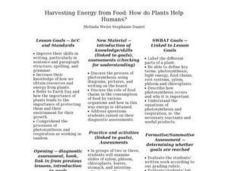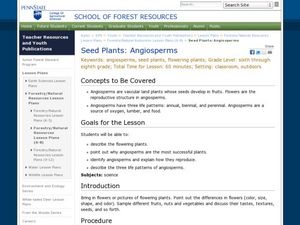Biology Junction
Nonvascular and Simple Vascular Plants: Mosses to Ferns
Sometimes conservationists use specific plants to prevent erosion or fight invasive species. A 50-slide presentation covers both nonvascular and vascular plants. It discusses the plants, their stages and life cycles, reproduction, uses,...
Scholastic
Study Jams! Mosses and Ferns
Mosses and ferns are some of the world's oldest types of plants. Here is a quality 10-slide presentation set to gentle background music for beginning botanists to view and enjoy. Accompanying captions explain that these are both...
Curated OER
Introduction to Plants
A vast overview of avascular and vascular plants, this PowerPoint displays all of the notes your botanists need to take. It lists primitive plant groups and their characteristics. It separates gymnosperms and angiosperms, also detailing...
K-State Research and Extensions
You Ol’ Fossil
Geologists are gneiss, tuff, and a little bit wacke. The fifth chapter of seven includes ten activities at four different levels. The hands-on activities cover fossils including how they are formed, vertebrates, invertebrates,...
Curated OER
Characteristics of Plants
In this characteristics of plants worksheet, students name two things that all plants have in common. Then they describe how the cell walls and cuticles help plants adapt to life on land. Students also explain the difference between...
Biology Junction
Plant Structure and Function: Roots, Stems, and Leaves
Scientists found fossils of plants more than 420 million years old—but plants existed for up to 100 million years prior to these fossils. Learn about the importance of plants to the entire planet. Viewing a presentation helps scholars...
Biology Junction
Seed Plants: Gymnosperms and Angiosperms
One of the reasons plants found success on land relates to seed development. Scholars learn about many different forms of seeds and how they changed over time. It describes the structure and function of many different types of seeds in...
Curated OER
Seedless Plants
Journey through the world of seedless plants with this visually appealing PowerPoint. Physical characteristics of mosses, liverworts, ferns, horsetails, and club mosses are detailed in bullet-point fashion. If possible, have living...
Scholastic
Study Jams! Plants without Seeds
Non-vascular plants do not develop seeds in order to reproduce. There are also some vascular plants that do not put out seeds. By viewing and reading through these six slides, green thumbs learn about mosses, liverworts, and ferns. They...
Curated OER
Seedless Plants
In this plant worksheet, learners complete 1 short answer question and 6 fill in the blank statements using a word bank about seedless plants.
Biology Junction
Introduction to the Plant Kingdom
Plants provide humans with food, shelter, and medications. Scholars gain a better appreciation for plants after learning their functions, divisions, and early ancestors. Each sub-topic includes slides highlighting vocabulary and...
Curated OER
Raven Chapter 35 Guided Notes: Plant Form
The ups and downs of plant vascular tissue are described by your beginning botanists as they complete this worksheet. Xylem and phloem are defined and identified on actual color photographs. Functions of the different types of meristem...
Curated OER
Investigation Xylem
Learners investigate how water travels up the stem of vascular plants by using food coloring to stain the xylem of a number of different plants. They know the function of leaves, stems, and root at the end of the experiment.
Curated OER
Seedless Vascular Plants
In this fern and gymnosperm worksheet, students will study a diagram of the life cycle of a lycophyte and then correctly order four life cycle statements. Then students will complete two true or false statements about fertilization of...
Curated OER
Plants: Form and Function
In this plants worksheet, students compare and contrast vascular and non-vascular plants. Students learn the structure and function of the 3 types of plant tissues: dermal, ground, and vascular tissue. This worksheet has 27 fill in the...
Curated OER
How Do Plants Move Materials?
In this plant worksheet, students will write 1 main idea on how plants move materials. Then students will write in 3 details about how nonvascular and vascular plants moves materials including the upward flow of water. This worksheet is...
Alabama Learning Exchange
What Kind of Plant is it?
Students evaluate the differences between vascular and nonvascular plants and practice classifying the plants into categories. They demonstrate using drawing software to create two slides showing vascular plants and nonvascular plants.
Curated OER
Harvesting Energy from Food: How do Plants Help Humans?
Beginning botanists view slides of plant vascular tissue. They watch Magic School Bus Gets Planted, which you can find online, and then write a summary of what they have learned about plants. This lesson could be used with upper...
Curated OER
What Makes a Plant a Plant?
For a plant unit in your biology curriculum, here is a slide show that bestows the basics of plant structure, reproduction, and classification. The information is general. The main point of the lesson is to highlight what characterizes...
Curated OER
How Are Plants Classified?
In this plant classification worksheet, students compare and contrast the two groups of plants: vascular and nonvascular plants. This worksheet is a graphic organizer.
Curated OER
Non-Seed Vascular Plants
In this non-seed vascular plant worksheet, students review the characteristics of sporophytes, lycophytes, sphenophytes, and pterophytes. This worksheet has 19 fill in the blank, 4 true or false, and 2 short answer questions.
Biology Junction
Introduction to Plants
In this biology lesson, students identify the different types and parts of the plant. They complete a crossword puzzle with 37 questions about plants.
Curated OER
Seed Plants: Angiosperms
Middle schoolers describe flowering plants and see why angiosperms are the most successful plants. In this angiosperms lesson plan students identify angiosperms and explain how they reproduce.
Curated OER
Reviving Celery
The classic in-class demonstration using celery dipped into water with food coloring is the highlight of this biology lesson plan. Young scientists discover that organisms are made up cells and have distinguishing characteristics. After...
Other popular searches
- Non Vascular Plants
- Nonvascular Vascular Plants
- Non Vascular Plants
- Seedless Vascular Plants
- Vascular Plants Venn Diagram
- Vascular Plants Lesson
- Non Vascular Vascular Plants
- Vascular Plants Lesson Unit























